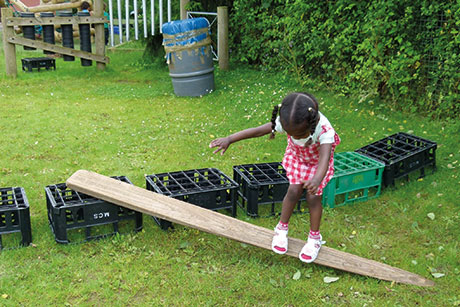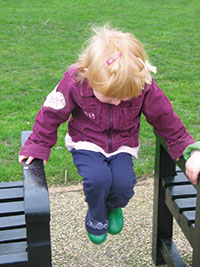
Download the PDF of this article
Negotiating changing levels and uneven surfaces is a crucial skill – the world is not flat, smooth and covered in rubber crumb. We can help young children build confidence and strength by providing physical challenges using the landscape features on the doorstep. Repeatedly navigating steps and ramps helps prevent these features from becoming trip hazards.
1 BOUND AND BOUNCE
Learning to land a jump safely is an important skill. Choose a set of steps with at least three levels, and a clear space at the bottom. Begin by jumping in the air from the ground, modelling a good landing, which involves landing on the whole foot and sinking deeply into the landing by bending both knees. Now test their landing bounces:
Bound from each step, starting from the lowest. Children will need to use their whole bodies to propel themselves as they move up the steps and further away from the landing zone.
How far can children bound from the lowest step? Lay a metre rule on the ground and mark each child’s landing spot so they can examine how far they’ve jumped. Now jump from a higher point (e.g. a piece of play equipment or a low wall). Can children jump further if they start higher up?
2 NUMBER
Collect at least ten sets of numbers from 1 to 5: e.g. mirror numbers, multilink blocks, laminated numbers, wooden numbers, a chopped up number line and so on. On the longest flight of steps you have outdoors, count the number of steps, with the lowest step being 1. Place the first set of numbers on the appropriate steps. Now seek out other spaces in the garden that have more than one step up – for example, play equipment, kerbs, a stage or amphitheatre, a ladder, even a climbing tree. Place each set of numbers on its own set of steps, until you’ve run out of steps or number sets. Are there numbers left in any of the sets? How many 5s do you have left? Why?
3 RUN UP AND DOWN
Being able to manage their bodies at speed on inclines and uneven slopes is essential – and yet how often do we remind children to ‘use the handrail’ or ‘slow down’ or ‘hold my hand’? If you have a mound or a long ramp, take small groups of children to practise moving up and down, organising their bodies and problem-solving as they go. As they build confidence, encourage them to move more quickly – to run, or skip, or bounce as they go along. There will be some tumbles – but try to resist stepping in immediately. Offer to ‘spot’ children – standing close by, with your arms extended towards the child, but not touching them. Juliet Robertson has an illuminating blog post on negotiating slopes at the beach (https://bit.ly/2KZNAs9).
4 SCIENCE LAB SLOPES
Explore the properties of gravity and Newton’s laws of motion:
Choose a selection of toy vehicles and draw a chalk line at the top of a ramp. Can children predict which vehicle will make it to the bottom of the slope first? What properties does the vehicle have that makes the child think that – e.g. wheel size, weight, size? Why don’t they roll up the slope?
Repeat the activity using balls.
 MINI-PARKOUR
MINI-PARKOUR
Parkour, sometimes known as free-running or urban gymnastics, is a fantastically fun discipline. Devise a parkour route around the steps, slopes, ledges and ramps in your garden, looking for opportunities to jump over obstacles, leap down several steps, roll down slopes and spin over handrails. Children should aim to ‘join up’ each movement, jogging or running between each parkour ‘station’ to raise their heart rate, and incorporating fixed play equipment if you have it.
And another thing…
Remember to ‘benefit risk assess’ these activities: check that the surfaces you plan to explore are free of sharp objects and that children have appropriate footwear for the activity.









